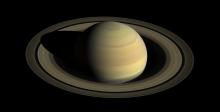Listen to today's episode of StarDate on the web the same day it airs in high-quality streaming audio without any extra ads or announcements. Choose a $8 one-month pass, or listen every day for a year for just $30.
You are here
Earliest Sunsets
The Sun isn’t a very good clock. The time it takes to move from one “noon” to the next can vary by almost half a minute per day. And that creates some interesting effects. One example is that the year’s earliest sunsets come days or weeks before the shortest day of the year.
There are a couple of reasons for that. One is Earth’s tilt on its axis. It causes the angle and location of sunrise along the horizon to change day by day. The other is Earth’s lopsided orbit. That causes the Sun to return to the same point in the sky a little earlier or later in the day, depending on whether we’re close to the Sun or far away.
Earth is close to the Sun in December, so it moves faster than average. As Earth rotates, it catches up to the “noontime” Sun a little earlier each day—by as much as 30 seconds.
Because of that, sunrise and sunset occur a little earlier, too. From here in the United States, the earliest sunsets of the year come a few days or weeks before the shortest day of the year — the winter solstice, on December 21st.
The exact date of earliest sunset varies by latitude. From the southernmost latitudes, it happens in late November or early December. From the latitude of Denver or Philadelphia, it happens about December 10th. And from Minneapolis or Seattle, it comes closer to the solstice.
The date of the latest sunrise comes about the same gap after the solstice — another result of the imperfect solar clock.
Script by Damond Benningfield






